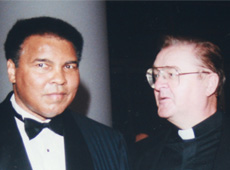Fr. Sean Mc Manus in Bobby Sands Film–66Days
Posted By: July 25, 2016
Film Review: ‘Bobby Sands: 66 Days’
Dennis Harvey
Film Critic
Courtesy of Hot Docs Film Festival May 19, 2016 | 10:44PM PT
A terminal hunger strike that caught the world’s attention is recapped in “Bobby Sands: 66 Days.”
A terminal hunger strike that caught the world’s attention — and arguably helped shift the struggle for Irish independence away from terroristic violence — is recapped in “Bobby Sands: 66 Days.” Veteran documentarian Brendan J. Bryne’s feature does an excellent job contextualizing this famous chapter for viewers not already steeped in modern Irish history. He also accentuates the drama of events to create what many may find a more engrossing (as well as complexly balanced) treatment than Steve McQueen’s 2008 “Hunger,” which had Michael Fassbender as Sands. It should prove a viable niche theatrical release in select territories, with slightly wider home-format exposure to follow.
Sands was 27 when he died on May 5, 1981 after refusing food for the titular 66 days. He was radicalized by the rise in Northern Ireland sectarian tension and violence during his youth, which had driven his own Catholic family from their home. At age 18 in 1972 he joined the Provisional IRA, getting arrested later that year on a weapons possession charge. The same scenario unfolded not long after his release from prison in 1976. While during his first stint he and other political prisoners were afforded “Special Category Status” allowing them somewhat different treatment from ordinary offenders, that exemption had been eliminated by the time of his 1977 re-entry.
Republican inmates deployed various tactics to protest that policy change, including refusing to wear prison uniforms and creating grossly unsanitary cell conditions. But these had little desired effect. Once Margaret Thatcher became Prime Minister in 1979, the U.K. government took a hard line of viewing all such activism as “blackmail” demanding “special privileges” for common criminals. It was against such opposition — and, to an extent, the IRA’s own disapproval after a prior such action had failed — that Sands commenced his second, final hunger strike, eventually joined by several others.
One voice among the rich array of observers that Bryne has assembled here comments early on that Bobby Sands was “the perfect icon,” being a figure of demonstrable passion and sacrifice, yet also a sort of blank slate (due to his youth and largely incarcerated history) onto which almost any qualities or message could be projected. That he was well aware of the martyr role he’d chosen is implicit in the articulate journal excerpts read on the soundtrack by Martin McCann. Even those who knew Sands tend to talk about him less in personal terms than as a sort of conscious symbol.
In the end, “66 Days” argues, his death not only won most of the contested prisoner rights, but made a significant case for “the power of self-inflicted suffering” as being more effective than violence in serving the cause. (The international-publicity impact was heightened still further when Sands was successfully elected to the British Parliament just weeks before his demise, proving considerable public sympathy lay on his side.)
Structured as a fatal countdown of days, Bryne’s docu (with much help from Paul Devlin’s inventive editing) manages to sandwich in a lot of diverse, useful errata, from general historical background to pulse-takings of the then disco-crazed popular culture simultaneous to this deadly serious conflict.
Primary package elements are a wealth of archival footage, and latterday talking-head contributions from various contemporaries, historians, medical experts, et al. “66” also weaves in low-key, wordless reenactment elements, and even a couple impressive animated sequences. Reflecting and further enhancing the film’s complicated agenda is an original score by Edith Progue that runs the gamut from duly disco-influenced music to aptly more somber themes.
While hardly the first and unlikely to be the last cinematic word on its subject (which was also notably dramatized by Terry George in the 1996 feature “Some Mother’s Son”), this finely crafted docu may well long stand as the most balanced among such treatments, as it respectfully examines Sands’ folk-heroic legacy rather than simply amplifying it.
Film Review: ‘Bobby Sands: 66 Days’
Reviewed at Hot Docs, May 5, 2016. (Also in Sheffield Doc Fest.) Running time: 105 MIN.
Production
(Documentary — Ireland-U.K.) A BBC Northern Ireland and BBC Storyville presentation of a Fine Point Films and Cyprus Avenue Films production in association with Northern Ireland Screen. (International sales: Content Media Corp., London.) Produced by Trevor Birney, Brendan J. Byrne. Executive producers, Nick Fraser, Susan Lovell, Justin Binding, Rory Gilmartin, Andrew Reid, Jonathan Ford, Greg Philips, Axel Arno, Mette Hoffmann Meyer.
Crew
Directed by Brendan J. Byrne. Camera (color, HD), David Barker; editor, Paul Devlin; music, Edith Progue; production designer, David Craig; art director, Chris Hunter; sound, Barker; re- recording mixers, Paul Maynes, Aaron O’Neill; animation, Peter Strain, Ryan Kane.
With
Fintan O’Toole, Raymond McCord, Denis Sweeney, Richard English, Denis O’Hearn, Michael Biggs, Tim Pat Coogan, Brendan O’Cathaoir, Jack Foster, Tomboy Louden, Danny Morrison, Seanna Walsh, Danny Devenney, Gerard Rooney, Gerry Adams, Richard O’Rawe, Dessie Waterworth, Norman Tebbit, charles Moore, Colm Scullion, Bik McFarlane, Thomas Hennessey, Lawrence McKeown, Dr. Hernan Heyes, Jim Gibney, Owen Carron, Ronnie Close, Father Sean McManus, Sean Donlon, Matthew Murray, Aram Bakshian, John O’Connell.
Filed Under:
• Bobby Sands: 66 Days
• Brendan J. Bryne










